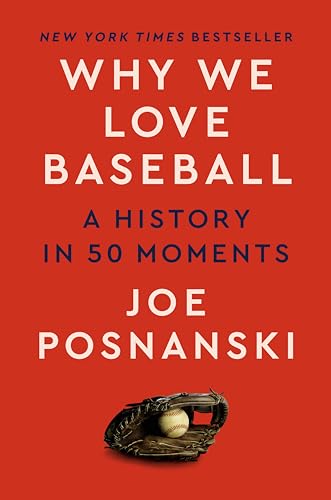Why We Love Baseball: A History in 50 Moments

Winner of the 2021 Casey Award as the Best Baseball Book of the Year with The Baseball 100, Joe Posnanski has followed up with another baseball title. Although promising A History in 50 Moments, Posnanski early on admits that, in fact, he has chosen 108 moments to explain Why We Love Baseball. The 50 Moments are offered in descending order, 50 to 1, and before each grouping there are categories of moments, 11 in all, on subjects such as Trick Plays, Blunders, Funny Things, Unlikely Home Runs, and more. There are two moments in the Introduction and one more in what might be termed the preface. There were in fact more as Posnanski lists several more for each major league team.
Many of the stories retold by Posnanski will be familiar to readers. In most cases, if the story is familiar, Posnanski will take that story to another dimension revealing something that adds to the tale or that enriches it in some way. Some of these enhancements will go off into a related event or personality and will add layers of meaning and/or emotion to the tale.
Many moments will be unfamiliar to most readers. In these cases Posnanski brings his storytelling abilities to the fore. He can frame a story with great skill and provide descriptions that will become part of the reader’s baseball memories. Each has some value in answering the statement “Why We Love Baseball.”
Choosing and ranking the 50 best moments in baseball is a dubious task and will offer complete satisfaction to no one. Each reader will bemoan the absence of some favorite moment, some favorite player or team. In that sense, Posnanski is on a fool’s errand. Of course, that is not the point. What he does offer to readers is a memory bank that will jar and rekindle their favorite baseball moments, allowing them to revisit the moment or simply reignite memories that have slipped away.
In some ways, the 58 additional moments grouped in categories, like those mentioned above, are the real treat of the book. These are often fleeting moments, gone before they take their place in the memory bank. Some can only be described as marginal. Posnanski’s resurrection of these moments leads to the exclamation, “Oh yah, I remember that,” or “Wow, I wish I had seen that.”
Among the improbable and largely unimportant is Gaylord Perry’s one homerun. It came 17 minutes after an important national event and was preceded seven years before by a comment on the likelihood of Perry ever hitting a home run. This is the opening story in the book found just before the Introduction.
Normally a tag of a runner on a stolen base attempt doesn’t get much attention. Such was not the case with Javy Baez, whose tags are described by Posnanski as “an art form.” The best of these is recounted in the “Five Trick Plays” section when Baez celebrated the out before he made the tag.
In “Five Unlikely Home Runs,” a moment remembered by the people in Atlanta, including many not at the game and perhaps not even Braves fans, is pitcher Rick Camp’s July 4 homerun. Homeruns by Al Weis and Tom Lawless, which came in World Series games, are included, as is the unlikely home run by Bartolo Colon in May of 2016. Colon struck out in half of his plate appearances, and he had not had a hit yet that season. Best of all he simply did not look like a ballplayer or any kind of athlete, and his homerun trot was one of the longest in the history of the game.
In the countdown of moments, Duane Kuiper’s only homerun of his big-league career leads off as moment number 50. It was his one home run in 3,754 plate appearances. Posnanski has a personal connection to the moment, and he offers an interesting postscript to the story.
In moment 48, Posnanski tells the story of the Niekro brothers, Joe and Phil, who learned to throw the knuckleball from their father, who learned it from a co-worker in an unlikely location. Also, a surprise is the recounting of Pedro Martinez’s best pitching performance on a Friday night late in the 1999 season against the Yankees in New York. In addition, there are no-hitters and near no-hitters and any number of great pitching performances.
Among those names that may be new to many readers is Ponderous Joe Bauman and his homerun records. There is a raft of famous home runs, some called shots and others not. There are game winning hits and game losing blunders. Humor is found in nearly every section, including the great rants by Lee Elia and Tommy Lasorda.
It is no surprise that the Number One Moment belongs to Hank Aaron and the homerun that made him the new homerun king of all time. Posnanski captures the details of the game and the homerun, and all that accompanied that moment. In this section, Posnanski writes beautifully about the man and his struggles, before and after the moment, and captures the elegance of the human being, the essence of Henry Aaron. If nothing else in this volume explains Why We Love Baseball, then this section on Henry Aaron will by itself do so.
In the Epilogue, Posnanski puts a cherry on the top of his baseball confection with a few words on Ichiro, the joy with which he played and the joy he brought to others.
Why do we love baseball? Posnanski has tried to count the ways, but clearly 108 moments is not enough.